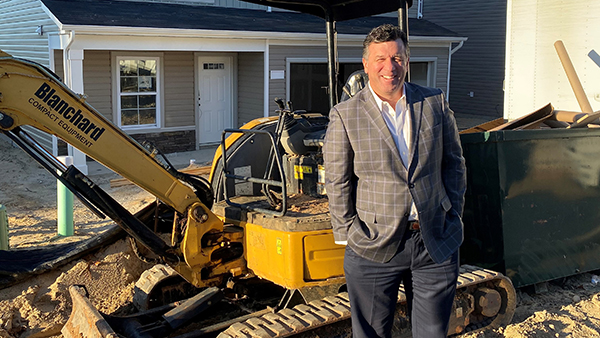In early April, I read a well-known real estate website and came across an article that discussed potential ramifications of the COVID-19 crisis on the real estate market. In one scenario, the article stated that potential listings will remain low, interest rates will remain low, and homes are likely to maintain their value.
Yet, in another section of the article, the author added some big caveats. Rising unemployment could tank the economy. A recession could dampen demand, which could cause home prices to plummet.
In short, the author really had no idea what was about to transpire. I can understand why. COVID-19 created a scenario no one had encountered before. Making a definitive prediction about market direction with the information at hand became virtually impossible.
My take-away from the article? No matter how well the market is moving along — and it was still pretty hot pre-virus — real estate investment always comes with risk. As a real estate developer and investor, one of the most important strategies is to mitigate risk wherever and whenever possible. It’s why my company Kinloch Partners has adopted a new investment model that spreads more of the risk — and perhaps more importantly rewards — to our builder partners.
We call it Build-FOR-Rent, rather than Build-TO-Rent, and while it sounds like a small difference in language, it can make all the difference between success and failure for the single-family rental strategy. At the same time, it provides a nice safety net for builders, who otherwise might sit on the sidelines during volatile stretches in the housing market.
Under the Build-TO-Rent model, we were wearing multiple hats, including developer and builder. We assumed the risk at every stage of development and construction. Under Build-FOR-Rent, we are contracting with a builder but asking them to shoulder some of the risk. Here’s a look at how it works:
Build-to-Rent Creates End-to-End Risk for Developers
I’ve been investing in single-family rental homes since 2005, using a mixture of strategies, including buying homes from distressed builders at a discount, building homes with the express purpose of building a rental business, and building entire subdivisions — creating entire rental communities. Each of these strategies comes with its own inherent risk.
As a developer who also wears the homebuilder hat, our risk started right out of the gate. We were tasked with land acquisition, the entitlement process, design and engineering, among other items. All of those tasks took time and money, even before the first yard of dirt was moved.
Once we got rolling with grading, we had to install utilities. Once those initial stages were completed, we had to put on our homebuilder hat. At that point, we were on the hook for material and labor costs and we had to meet our own construction deadlines. If we weren’t meeting deadlines, we were paying interest on loans that weren’t bringing in any rental income. As they say, time is money, and missed construction deadlines add up to lost money daily.
That whole process, from initial inception of an idea to completed construction, represents multiple steps where something can go wrong. And, of course, everything that goes wrong equals a cost overrun that erodes profit margins even before the first renter signs a lease.
Traditional builders manage these risks on their own as a routine course of running their business. Bringing a project in on time and under budget is the builder’s area of expertise. But, when traditional builders go to sell, they pay commissions, incur marketing costs, and assume the risk of the bottom falling out of the market and no one willing to purchase their homes. In tough times, it’s easy for builders to end up with houses sitting vacant, with a big bank loan coming due.
I have purchased hundreds foreclosed properties over the years from subdivisions to building lots to single-family houses, townhouses and condos. The majority of these have been purchased from banks and the loans that went bad were from builders and developers. In my experience, very few single-family rental owners have gone bankrupt or lost their houses to a bank. It would be tough to do, as the business is relatively simple — buy a house, find renters, then hold for long-term appreciation or package and sell a portfolio of rental homes to institutional funds. I do both.
But, to be truthful, instead of buying distressed properties, we’d much rather have long-term relationships with builders that are mutually profitable. That’s where a Build-For-Rent partnership is a great strategy.
Build-for-Rent Combines Risk and Reward for Builders and Investors
A Build-For-Rent strategy combines the best skill sets of developers, builders, and property management companies. It helps mitigate construction cost risk in a project’s early phases, then weeds out the cost — and risk — of marketing and selling the house at construction completion.
In this scenario, the investor does not become the property owner until the home’s completion. The sale and the sale price will have been negotiated up front in partnership with the builder. Both parties focus on what they do best: the builder focuses on managing the construction process, while the investor focuses on finding renters and managing the property. This arrangement cuts out all costs of marketing and selling the house and eliminates the risk of the house sitting on the market for months.
With Build-for-Rent, we typically pay a slight premium for the homes in comparison to an end-to-end Build-to-Rent scenario, but we know the homes will be done right and done on time. The higher price is also our reward to the builder for helping shoulder their portion of the risk.
We have formed relationships with local, regional and national builders to put this strategy to work. We negotiate discounts from these builders that average 10-to-15 percent reductions to appraised values. As an investor, I’m happy paying more for a negotiated home price up front. I know exactly what I need in rental income to meet my metrics and I have completely removed construction headaches and potential cost over-runs off of my plate.
Build-for-Rent Partnerships Work as Rental Homes Stay Hot
Builders and investors need to seek these types of partnerships as the rental home market is highly likely to stay hot. Millennials (born between 1981 and 1998) continue to start families. Unfortunately, they are saddled with a large portion of our nation’s $1.6 trillion in student debt. They still want a house with four sides and a yard for their children to play. Renting a single-family home makes sense for them.
Builders want to stay in business, but the risk of putting up spec houses in an unpredictable market might keep builders on the sideline.
Real estate investors are always looking for another avenue to generate a return. The returns from single-family rentals can provide a safe haven in an otherwise volatile market.
Throw all these factors together and a Build-for-Rent scenario is a win-win-win for builders, investors, and consumers alike. It’s highly likely we’ll see this scenario continue to grow over the coming months.
























0 Comments